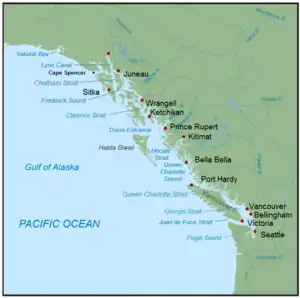Pseudoceros canadensis
Pseudoceros canadensis is a species of free-living, flatworm in the genus Pseudoceros, belonging to the family Pseudocerotidae.
| Pseudoceros canadensis | |
|---|---|
| Scientific classification | |
| Kingdom: | Animalia |
| Phylum: | Platyhelminthes |
| Class: | Rhabditophora |
| Order: | Polycladida |
| Family: | Pseudocerotidae |
| Genus: | Pseudoceros |
| Species: | P. canadensis |
| Binomial name | |
| Pseudoceros canadensis | |
Physical characteristics
These flatworms are acoelomate bilaterians. They lack respiratory and circulatory systems and therefore diffuse oxygen and CO2 through the body surface, which is made possible due to them being highly flattened, which increases their surface area to volume ratio.[2] However, this limits their maximum in size. They possess digestive systems, which allows them to process complex dietary items. They possess a protrusible pharynx to collect food.[3]
Platyhelminthes have a high degree of cephalization with an obvious head-end. Pseudoceros have a distinctive anterior folding of the body to make 2 tentacles known as "false horns".[4]
Vision
The right cerebral eye of the larval stage has 1 cup-shaped pigment cell & 3 sensory cells that have microvilli. The left eye of the larval stage is composed the same with the exception of an additional sensory cell containing multiple cilia. The epidermal ocellus of the larval stage is composed of a cup-shaped pigment cell containing flattened cilia and photoreceptors nad a cell above the cup that contains noncilliar lamellae. The eyes of the adult stage only contain microvillar receptors.[5]
Movement
Members of the class Turbellaria are covered in cilia that allows for movement.They secrete a mucus and beat ventral cilia within the mucus to move along a ventral surface.[6] They can also move through a series of pedal waves, which is when the ventral surface contracts in waves along the body, propelling the organism forward.
Reproduction
Pseudoceros canadensis are simultaneous hermaphrodites that use a form of hypodermic insemination known as penis fencing to determine which breeding partner is the female, and which is the male. Gametes are passed from the victorious male into the female by puncturing the body wall and injecting them with gametes.[7] After fertilization, eggs are laid and develop into Muller's larvae (a free-swimming larval stage).[8]
Distribution

Unlike other species of the genus Pseudoceros, Pseudoceros canadensis is found in colder waters.[9] It lives within the range of the Puget Sound, which is an inlet in the Pacific Ocean located along the northwestern coast of the US state of Washington, and British Columbia (Northwesternmost Province of Canada).[10]
Diet
Adults are known to eat ascidians, or sea squirts. Eating is aided by the use of a protrusible pharynx located on the anterior of the organism. In the Muller's larval stage they have been found to eat microalgae using ciliary beat reversal to alter near-field flow and draw in food particles toward the mouth.[11]
References
- Ching, H.L. (1978) Redescription of a marine flatworm: Pseudoceros canadensis Hyman, 1953 (Polycladida: Cotylea). Canadian Journal of Zoology 56(6): 1372-1376.doi: 10.1139/z78-189
- Schockaert E.R., Hooge, M., Sluys R., Schilling, S., Tyler, S., and Artois, T. (2008) Global diversity of free living flatworms (Platyhelminthes, ‘Turbellaria’) in freshwater. Hydrobiologia 595: 41–48, doi:10.1007/s10750-007-9002-8
- Martín-Durán J.M., Egger, B. (2012) Developmental diversity in free-living flatworms. Evodevo 3(7). doi:10.1186/2041-9139-3-7
- Lacalli, T.C. (1983). The brain and central nervous system of Müller’s larva. Can J Zool 61:39–51, doi: 10.1139/z83-004.
- Eakin, R.M., and Brandenburger, J.L. (1981) Fine Structure of the eyes of Pseudoceros canadensis (Turbellaria, Polycladida). Zoomorphology 98: 1-16
- Wanninger, A. (2009) Shaping the Things to Come: Ontogeny of Lophotrochozoan Neuromuscular Systems and the Tetraneuralia Concept. The Biological Bulletin 216(3):293-306
- Chim, C.K., Ong, R.S.L., and Gan, B.Q. (2015) Penis fencing, spawning, parental care and embryonic development in the cotylean flatworm Pseudoceros indicus (Platyhelminthes: Polycladia: Pseudocerotidae) from Singapore. Raffles Bulletin of Zoology 31: 60-67.
- Janssen, T., Vizoso, D.B., Schulte, G., Littlewood, D.T., Waeschenbach, A., and Schärer L. (2015) The first multi-gene phylogeny of the Macrostomorpha sheds light on the evolution of sexual and asexual reproduction in basal Platyhelminthes. Mol. Phylogenet. Evol. 1: 82–107, doi:10.1016/j.ympev.2015.06.004
- Hyman, L.H. (1954) The Polyclad Genus Pseudoceros, with special reference to the Indo-Pacific Region. Pacific Science 8:219-225
- Hyman, L.H. (1953) The Polyclad Flatworms of the Pacific Coast of North America. American Museum of Natural History Bulletin 100: 265-392
- Von Dassow, G., and Ellison, C.I. (2020) Large-scale Ciliary Reversal Meditates capture of individual algal prey by Miller's larva. Invertebrate Biology. doi:10.1111/ivb.122274